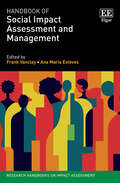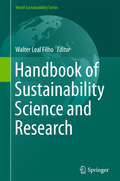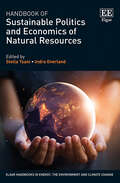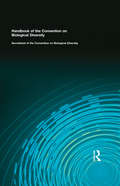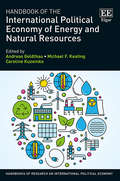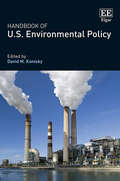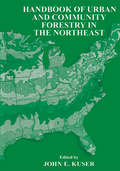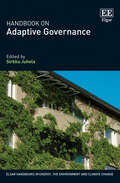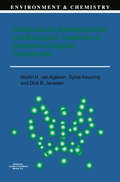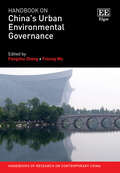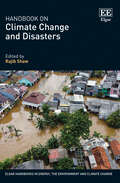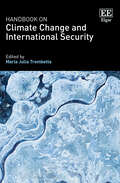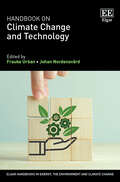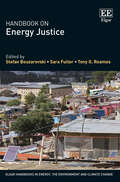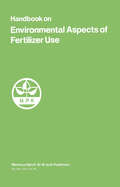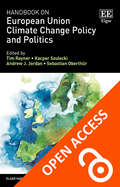- Table View
- List View
Handbook of Social Impact Assessment and Management (Research Handbooks on Impact Assessment series)
This carefully conceived Handbook presents a state-of-the-art discussion of the field of social impact assessment (SIA), highlighting contemporary understandings and emerging issues in this continually evolving area of research and practice. Experienced SIA practitioners from around the world share their learnings and advice on a comprehensive range of issues faced in social performance practice. They explore how SIA has moved far beyond its original role as an ex-ante input into a regulatory environmental licensing process to now serving multiple stakeholders at all stages of the project lifecycle and seeking improved outcomes for host communities. The chapters also reveal how the field and practice of SIA connects with wider discourses, including: business and human rights; environmental, social and governance (ESG) performance; and social licence to operate. Providing an extensive overview of the field of SIA, this incisive Handbook is essential reading for: SIA practitioners; researchers of environmental sociology, environmental psychology, human geography, community psychology, or applied anthropology; and other people with an interest in the social impacts of projects. The Handbook's exploration of how SIA might contribute to better outcomes for communities and projects will also benefit individuals and organizations who commission and review EIAs and SIAs, environmental, social and community NGOs, as well as members of project-affected communities.
Handbook of Spatial Point-Pattern Analysis in Ecology
by Thorsten Wiegand Kirk A. MoloneyUnderstand How to Analyze and Interpret Information in Ecological Point PatternsAlthough numerous statistical methods for analyzing spatial point patterns have been available for several decades, they haven't been extensively applied in an ecological context. Addressing this gap, Handbook of Spatial Point-Pattern Analysis in Ecology shows how the t
The Handbook of Sustainability Literacy: Skills for a Changing World
by Arran StibbeA vital resource for sustainability educators, learners and decision-makers on how we can build a more sustainable future. In this ground-breaking book, leading sustainability educators are joined by permaculturists, literary critics, ecologists, artists, journalists, engineers, mathematicians and philosophers in a deep reflection on the skills that people need to survive and thrive in the challenging conditions of the 21st century. Responding to the threats of climate change, peak oil, resource depletion, economic uncertainty and energy insecurity demands the utmost in creativity, ingenuity and new ways of thinking to reinvent self and society. Among the many skills, attributes and values described in The Handbook of Sustainability Literacy are values reflection, coping with complexity, permaculture design, transition skills, advertising awareness, effortless action, and ecological intelligence, each accompanied by ideas for active learning exercises to help develop the skill. Far from being a rigid or definitive statement of the one right way however, the handbook is exploratory, aiming to open up new, unthought-of paths, possibilities and choices. With contributors including John Naish, Satish Kumar, Patrick Whitefield, John Blewitt, Stephan Harding and Stephen Sterling, this is intended for educators, learners and anyone else interested in the vital issue of the skills we need to survive and thrive in the 21st century and build a more sustainable future.
Handbook of Sustainability Science and Research (World Sustainability Series)
by Walter Leal FilhoThis multidisciplinary handbook explores concrete case studies which illustrate how sustainability science and research can contribute to the realization of the goals of the 2030 Agenda for Sustainable Development. It contains contributions from sustainability researchers from across the world.
Handbook of Sustainable Apparel Production
by Subramanian Senthilkannan MuthuA hot-button societal issue, sustainability has become a frequently heard term in every industrial segment. Sustainability in apparel production is a vast topic and it has many facets. Handbook of Sustainable Apparel Production covers all aspects of sustainable apparel production including the raw materials employed, sustainable manufacturing proce
Handbook of Sustainable Politics and Economics of Natural Resources (Elgar Handbooks in Energy, the Environment and Climate Change)
This timely Handbook draws together insightful analyses of natural resource management challenges and solutions in the face of sustainable development targets and a changing global climate. Expert contributors illustrate the ways in which resource- and region-specific challenges shape national and global strategies, exploring the institutional aspects of resource management and their implications for policy making. They consider the economic, legal, environmental, social, financial and technological dimensions of resource management, consolidating interdisciplinary knowledge and setting the agenda for future research. Advancing scientific knowledge in the field, the Handbook offers a roadmap for well-informed policy making, highlighting the uncertainties and risks associated with climate change, energy and sustainability transition, and the need for a forward-looking approach to resource management. Assembling state-of-the-art contributions to provide a clearer understanding of the transformative policy developments ahead, this Handbook is crucial reading for academics and researchers of resource management, public policy, sustainability, energy transition, climate change and environmental studies. It also offers critical empirical insights for policy makers and practitioners developing innovative strategies to meet sustainability targets.
Handbook of the Convention on Biological Diversity
by Secretariat To CbdIn 1992, at the Earth Summit in Rio, the United Nations adopted the Convention on Biological Diversity (CBD) to agree international measures aimed at preserving the vital ecosystems and biological resources on which we all depend. This is the official handbook to the Convention and presents all the most important information about the CBD, including a guide to the decisions adopted and to ongoing activities. It is an essential resource for all the governments, intergovernmental agencies, NGOs and conservation bodies and researchers working in this area. Included with the book is a fully indexed and cross-referenced CD-ROM containing all the relevant background material to the Convention, linked to relevant decisions and other sources of information.
Handbook of the Convention on Biological Diversity
by Secretariat To CbdIn 1992, at the Earth Summit in Rio, the United Nations adopted the Convention on Biological Diversity (CBD) to agree international measures aimed at preserving the vital ecosystems and biological resources on which we all depend. This is the official handbook to the Convention and presents all the most important information about the CBD, including a guide to the decisions adopted and to ongoing activities. It is an essential resource for all the governments, intergovernmental agencies, NGOs and conservation bodies and researchers working in this area. Included with the book is a fully indexed and cross-referenced CD-ROM containing all the relevant background material to the Convention, linked to relevant decisions and other sources of information.
Handbook of the International Political Economy of Energy and Natural Resources (Handbooks of Research on International Political Economy series)
by Caroline Kuzemko Andreas Goldthau Michael F. KeatingThis Handbook offers a comprehensive overview of the latest research from leading scholars on the international political economy of energy and resources. Highlighting the important conceptual and empirical themes, the chapters study all levels of governance, from global to local, and explore the wide range of issues emerging in a changing political and economic environment. The original contributions analyse energy as a highly complex, interconnected policy area, including how energy markets and regimes are constituted and the governance institutions that are being designed to challenge existing establishments. A number of contributors focus on intersections between energy and other policy fields or sectors, or nexes. These include the climate change, energy and low carbon transitions nexus; the food, water and forestry nexus; the energy, resources and development nexus; and the global–national–local nexus in energy. Significantly, this Handbook ties the contributions together by exploring opportunities for sustainable transitions and avoiding resource scarcity whilst taking other social needs, such as development, into account. This Handbook will be an essential resource for scholars and students of international political economy, governance and development studies as it covers: the environment, development, human rights, global production, energy transitions and energy security.
Handbook of Transitions to Energy and Climate Security (Routledge International Handbooks)
by Robert E. LooneyAn original contribution to our understanding of a phenomenon that is reshaping the world, this title thoroughly discusses the transformation of the energy security policy arena brought on by two dramatic developments – the increased potential availability of energy in many parts of the world on the supply side, and on the demand side increasing concerns over the harmful effects on the environment brought on by the use of fossil fuels. An in depth discussion specifically focuses on what energy security means to different countries, and examines which of those countries appear to be managing their energy/climate transitions successfully and which are having a more difficult time adapting to the new environment. Part 1 introduces the topic, covering the main themes and provides an overview of the chapters Part 2 provides a framework for policy evaluation, considering the evolving factors affecting energy security and the energy/climate policy trilemma Parts 3 to 6 discuss energy transitions in the carbon producing countries (Saudi Arabia, Canada, Iran, Russia, Mexico), in intermediate carbon/producing/consuming countries (China, United States, UK, Brazil, Argentina, South Africa), in carbon consuming countries (Germany, Japan, South Korea, Israel, India, Spain) and finally in carbon reduction countries (France, Denmark, Switzerland) Part 7 looks at attempts at regional/international cooperation Part 8 considers the prospects for the future, examining technological breakthroughs. This title builds on the theme of unfolding energy transformations driven by, but increasingly constrained by climate/environmental considerations. It is ideal for researchers and students in the areas of environmental politics and policy, climate change, and energy and climate security, as well as for academics and professionals.
Handbook of Transitions to Energy and Climate Security (Routledge International Handbooks)
by Robert E. LooneyAn original contribution to our understanding of a phenomenon that is reshaping the world, this title thoroughly discusses the transformation of the energy security policy arena brought on by two dramatic developments – the increased potential availability of energy in many parts of the world on the supply side, and on the demand side increasing concerns over the harmful effects on the environment brought on by the use of fossil fuels. An in depth discussion specifically focuses on what energy security means to different countries, and examines which of those countries appear to be managing their energy/climate transitions successfully and which are having a more difficult time adapting to the new environment. Part 1 introduces the topic, covering the main themes and provides an overview of the chapters Part 2 provides a framework for policy evaluation, considering the evolving factors affecting energy security and the energy/climate policy trilemma Parts 3 to 6 discuss energy transitions in the carbon producing countries (Saudi Arabia, Canada, Iran, Russia, Mexico), in intermediate carbon/producing/consuming countries (China, United States, UK, Brazil, Argentina, South Africa), in carbon consuming countries (Germany, Japan, South Korea, Israel, India, Spain) and finally in carbon reduction countries (France, Denmark, Switzerland) Part 7 looks at attempts at regional/international cooperation Part 8 considers the prospects for the future, examining technological breakthroughs. This title builds on the theme of unfolding energy transformations driven by, but increasingly constrained by climate/environmental considerations. It is ideal for researchers and students in the areas of environmental politics and policy, climate change, and energy and climate security, as well as for academics and professionals.
Handbook of U.S. Environmental Policy
by David M. KoniskyA comprehensive analysis of diverse areas of scholarly research on U.S. environmental policy and politics, this Handbook looks at the key ideas, theoretical frameworks, empirical findings and methodological approaches to the topic. Leading environmental policy scholars emphasize areas of emerging research and opportunities for future enquiry. Separated into five distinct thematic sections, the Handbook moves from examining political institutions, to politics and behavior, policy tools and strategies, climate change, and finally ideas and challenges. Individually, each chapter provides readers with a clear synthesis of current research on a specific environmental policy topic. Together, they offer a thorough review of the current landscape of research in the field. Environmental studies and politics scholars will find the key case studies and in-depth theoretical discussions in this Handbook of great use. It will also be interesting reading for US policy-makers and those working in the media looking for a deeper understanding of the current state of affairs.
Handbook of Urban and Community Forestry in the Northeast
by John E. KuserWith the emergence of urban and community forestry as the fastest growing part of our pro fession in the last 15 years, the need for a book such as this inevitably developed. The So ciety of American Foresters' urban forestry working group counts 32 or more universities now offering courses in this subject, and the number is growing. For the last several years I have coordinated a continuing education urban forestry course at Rutgers for nonmatriculated students. Registrants have included arborists, shade tree commissioners, landscape architects, city foresters, environmental commissioners, park superintendents, and others whose jobs involve care and management of trees. The course was started by Bob Tate in 1980, around a core of managerial subjects such as in ventories, budgets, and public relations. After Bob left in 1984 to join Asplundh and later to start his own prosperous business in California, the course languished after it exhausted the local market for those subjects.
Handbook of Whales, Dolphins and Porpoises
by Mark CarwardineFrom the blue whale to the Indo-Pacific finless porpoise, this handbook is the most comprehensive, authoritative and up-to-date reference to each of the world's 90 species of cetaceans. With more than 1,000 meticulous and specially commissioned illustrations – complete with flukes, blows and dive sequences – it includes detailed annotations pointing out significant field marks, as well as extensive distribution and migration maps. Many of the world's most respected whale biologists have collaborated on the text, helping to provide the ultimate guide to the identification, distribution, behaviour, life history and conservation of every species and subspecies of whale, dolphin and porpoise. This is an indispensable resource for anyone interested in these truly spectacular animals.
Handbook of Whales, Dolphins and Porpoises
by Mark Carwardine'Everyone who loves the sea and what's in it should own this book.' Bill BrysonFrom the blue whale to the Indo-Pacific finless porpoise, this handbook is the most comprehensive, authoritative and up-to-date reference to each of the world's 90 species of cetaceans. With more than 1,000 meticulous and specially commissioned illustrations – complete with flukes, blows and dive sequences – it includes detailed annotations pointing out significant field marks, as well as extensive distribution and migration maps. Many of the world's most respected whale biologists have collaborated on the text, helping to provide the ultimate guide to the identification, distribution, behaviour, life history and conservation of every species and subspecies of whale, dolphin and porpoise. This is an indispensable resource for anyone interested in these truly spectacular animals.
Handbook on Adaptive Governance (Elgar Handbooks in Energy, the Environment and Climate Change)
The interconnectedness of global society is increasingly visible through crises such as the current global health pandemic, emerging climate change impacts and increasing erosion of biodiversity. This timely Handbook navigates the challenges of adaptive governance in these complex contexts, stressing the necessarily compounded nature of biophysical and social systems to ensure more desirable governance outcomes.Highlighting the dynamics and diversity of governance systems across the globe, leading experts in the field examine the successes and failures of these systems. Synthesising theory with methodology and practical case studies, chapters explore adaptive governance in forest management, marine environments and open data ecosystems, looking closely at the role of adaptive governance in climate mitigation and disaster risk reduction. Answering the call for large-scale transformations that move societies away from unsustainable development trajectories, this prescriptive Handbook explores the existing adaptive governance measures that have driven reflexive, sustainable change. Reflecting on the past decade of research in the field, it concludes by outlining new areas of contention and inquiry for the next decade of adaptive governance research.Interdisciplinary in scope, this comprehensive Handbook will prove an invigorating read for students and scholars of environmental law, governance and regulation, and political science and public policy. Policymakers looking to innovate their adaptive governance approaches will also find this a beneficial companion.
Handbook on Biodegradation and Biological Treatment of Hazardous Organic Compounds (Environment & Chemistry #2)
by M.H. van Agteren Sytze Keuning D. JanssenThe introduction of synthetic organic chemicals into the environment during the last few decades has given rise to major concern about the ecotoxicological effects and ultimate fate of these compounds. The pollutants that are considered to be most hazardous because of their intrinsic toxicity, high exposure level, or recalcitrant behavior in the environment have been placed on blacklists and other policy priority lists. The fate of synthetic compounds that enter the environment is mainly determined by their rate of biodegradation, which therefore also has a major effect on the degree of bioaccumulation and the risk of ecotoxicological effects. The degree and rate of biodegradation is also of critical importance for the feasibility of biological techniques to clean up contaminated sites and waste streams. The biodegradation of xenobiotics has thus been the subject of numerous studies, which resulted in thousands of publications in scientific journals, books, and conference proceedings. These studies led to a deeper understanding of the diversity of biodegradation processes. As a result, it has become possible to enhance the rate of degradation of recalcitrant pollutants during biological treatment and to design completely new treatment processes. At present, much work is being done to expand the range of pollutants to which biodegradation can be applied, and to make treatment techniques less expensive and better applicable for waste streams which are difficult to handle.
Handbook on China’s Urban Environmental Governance (Handbooks of Research on Contemporary China series)
This timely and comprehensive Handbook addresses how Chinese cities govern the environmental changes generated by fast economic growth and urbanisation. Outlining the relationship between the state, market, and society, this Handbook provides a systematic understanding of urban environmental governance in China.Exploring the context of changing urban environmental policies in China, leading international scholars highlight the arts of governance and governmentality through experimentation and discourse. Chapters investigate the political ecologies of eco-cities and conservation, urban waste management, and governance and sustainability transitions, as well as focusing on low-carbon innovations and green buildings. With a territorial perspective grounded in Chinese cities, contributors interrogate changing and complex state–market–society dynamics in urbanisation and urban environmental governance.With a thorough and systematic analysis of new environmental initiatives, practices, and impacts, this Handbook provides scholars, students, and policy researchers of environmental studies, politics, and East Asian studies with an exemplary selection of contemporary research on China’s urban environmental governance.
Handbook on Climate Change and Disasters (Elgar Handbooks in Energy, the Environment and Climate Change)
This comprehensive Handbook assesses the escalation of global natural disasters as a result of climate change. Examining the complex interplay of human and natural activities, it highlights the growing vulnerability of people and communities in developing countries to floods, landslides, cyclones, heat waves and wildfires. The Handbook opens with a global framework analysis, outlining the implications of the UN Sustainable Development Goals, the Paris Agreement and the Sendai Framework for disaster risk reduction. International contributors address the roles of stakeholders in mitigating climate hazards, as well as offer detailed analysis of cross-cutting issues, including poverty, health, education and gender. Concluding chapters address the future of climate change mitigation and disaster protection, exploring the growing role of emerging technologies in disaster resilience and sustainable development. Bringing together cutting-edge research from renowned global scholars and professionals, this Handbook offers key insights for researchers and students of environmental studies and development studies, particularly those focusing on natural disasters and climate technologies. The empirical data and case analysis will also benefit practitioners, professionals and policymakers working in climate risk relief.
Handbook on Climate Change and International Security
This topical Handbook explores the emergence of climate change as an international security issue, the threats it poses, and the political and academic debates it has prompted. Framing climate change as a security issue, it explores the ways relevant actors, states and international organizations have conceptualized climate security and its associated threats.Theoretically sound and empirically innovative, this Handbook explores the political implications of linking climate change and security and tackles the questions that are subsequently raised. Through a collection of international case studies, expert contributors explore a diverse range of issues emerging in the debate about climate change and security, including the problem of migration, the impact on energy security and the role of the military. Contributing to various discourses, logics, practices and constructions of climate security, the Handbook outlines how security language shapes and transforms the way climate change is governed. Ultimately, it identifies an emerging, broader reconceptualization of international security in the Anthropocene.Displaying the challenges that climate change poses in the context of existing security practices and institutions, this Handbook will be vital for policymakers looking to identify and understand threats to formulate effective countermeasures. It will also prove useful to students and scholars of security studies, international relations, climate change and energy politics, environmental politics and policy, and governance.
Handbook on Climate Change and Technology (Elgar Handbooks in Energy, the Environment and Climate Change)
This timely Handbook presents the latest knowledge on technological innovation for climate change mitigation and adaptation. Looking beyond technical fixes, it further draws on economics, politics and sociology to explore how modern technology can contribute to effective and socially just sustainability transitions.Examining cutting-edge research on energy, transport and industry, this Handbook argues that we have the technologies and policy instruments needed to mitigate and adapt to climate change. However, for larger-scale implementation the support at the socio-economic and political levels has to be increased. Chapters further analyse the role that technology plays in key sectors, such as agriculture and forestry, in order to become more sustainable. Contributors also reflect on the position of technology in society, illustrating the wider socio-technical systems that determine the impact that new technologies can have. They call for the political will to implement and scale up technological measures to address climate change across the world.The Handbook on Climate Change and Technology will be essential reading for academics and students of climate change, energy, sustainability and environmental governance and regulation. It will also be an invaluable resource for practitioners and policymakers seeking a deeper understanding of the role of technology in sustainability transitions.
Handbook on Energy Justice (Elgar Handbooks in Energy, the Environment and Climate Change)
Offering a unique and critical perspective on energy justice, this Handbook delves into an emerging field of inquiry encapsulating multiple strands of scholarship on energy systems. Covering key topics including generation, transmission, distribution and demand, it explores fundamental questions surrounding policy, climate change, security and social movements.The Handbook illuminates the rapidly expanding and diversifying scholarly domains where energy justice has developed to date. Chapters provide an overview on energy justice issues across a range of socio-technical and political contexts, including differences along lines of race, gender, age, geography, housing, socio-economic status and infrastructure. The Handbook further incorporates non-Western perspectives to expand the transitional vocabulary and frameworks of energy justice.Grounded in empirically rich case studies from across the world to support nuanced framings, situated methods and informed policy, this Handbook will be of interest to students of development, human geography, environmental policy and politics. It will also be useful to practitioners working in international organisations and agencies working in development and the environment.
Handbook on Environmental Aspects of Fertilizer Use
by International Potash International Potash Institute (IPI)Handbook on European Nuclear Law: Competences of the Euratom Community under the Euratom Treaty
by Rasa EngstedtEnergy and Environmental Law and Policy Series #39 While the European Economic Community has evolved through the decades into the legal entity of the European Union, the substantive law contained in the 1957 Euratom Treaty has never been amended. Recurring legal discussions of the treaty’s potentially obsolete nature give rise to this much-needed handbook, which provides systematic analysis and evaluation of the competences conferred under the Euratom Treaty. Following the structure of the Euratom Treaty, the author analyses and evaluates the scope, content, exercise, and case law of the Euratom Communities’ competences in the following fields: promotion of research, with reference to the Horizon research programmes; dissemination of information; health and safety, including environmental protection; investments; joint undertakings; nuclear supplies; safeguards; property ownership of fissile materials; the nuclear common market; and the Community’s external relations. The book deals with issues of stagnation and potential obsolescence through such lenses as the legislative amendment procedure, level of regulatory detail, quantitative elements of exercise, secondary legal acts, and the Court of Justice of the European Union’s power to define and delimit the Euratom Community’s competences. The competences in the fields of military activities and State aid are also examined in detail. The role of principles of subsidiarity and proportionality in European nuclear law and the issue of classification of competences under the Euratom Treaty are addressed in this book. With its systematic, chapter-by-chapter analysis of competences of the Euratom Community under the Euratom Treaty, the book will be welcomed by lawyers and negotiators working in nuclear field, researchers in nuclear law and in the broader competences of the EU, and policymakers in the European nuclear sector.
Handbook on European Union Climate Change Policy and Politics (Elgar Handbooks in Energy, the Environment and Climate Change)
The Handbook on European Union Climate Change Policy and Politics provides a wide-ranging and in-depth assessment of current and emerging challenges facing the EU in committing to and delivering increasingly ambitious climate policy objectives. It traces the development of climate and energy policies since the early 1990s and examines their continued evolution in the context of the 2019 European Green Deal.With contributions from leading international scholars, it describes the key dynamics driving policy developments and the role of key actors in climate and energy-related policy processes. Covering topics that have previously been relatively neglected, or have recently gained greater significance, such as finance and investment, ‘hard to abate’ sectors and negative emissions, this timely Handbook offers an up-to-date and unrivalled exploration of the complexities of climate policymaking.It will be of primary interest to academics researching EU politics, and environmental politics, policy, regulation and governance more widely. It will be especially pertinent to students and researchers who require more specialized knowledge of EU climate policy and politics.
